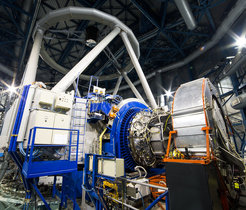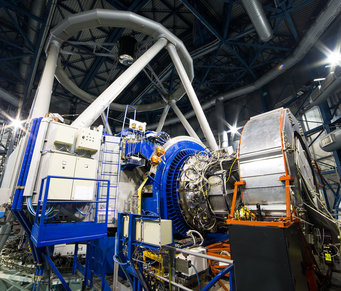24-armed Giant to Probe Early Lives of Galaxies
First light for KMOS instrument

The KMOS instrument mounted on ESO’s Very Large Telescope at the Paranal Observatory in Chile. In this picture KMOS is the silver structure at the centre, surrounded by the blue ring structure that connects it to the VLT Unit Telescope 1, which appears on the left. On the right the large silver cylinder supports the extensive KMOS electronics and allows them to rotate as the telescope moves across the sky.
The K-band Multi-Object Spectrograph (KMOS), attached to the Very Large Telescope (VLT) Unit Telescope 1 at ESO’s Paranal Observatory in Chile, has successfully achieved first light. During the four-month period from August this huge instrument had been shipped from Europe, reassembled, tested and installed following months of careful planning. This was the culmination of many years of design and construction by teams in the UK and Germany, and at ESO.
To study the early lives of galaxies astronomers need three things: to observe in the infrared, to observe many objects at once and, for each one, to map out how their properties vary from place to place. KMOS can do all of these things — at the same time. Up to now astronomers could either observe many objects at once, or map a single object in detail. A detailed survey might take years for a large sample of objects. But with KMOS, by mapping the properties of many objects simultaneously, such surveys can now be completed in just months.
"I am excited about the fantastic opportunities KMOS offers to study distant galaxies. The possibility to observe 24 galaxies simultaneously will allow us to build galaxy samples of unprecedented size and quality. The collaboration among all partners and ESO could not have been better and I am very grateful to everybody who contributed to the construction of KMOS," concludes Ralf Bender (University Observatory Munich and the Max Planck Institute for Extraterrestrial Physics, Garching), co-principal investigator.
KMOS has robot arms that can be positioned independently in just the right place to catch the light from 24 distant galaxies simultaneously. Each arm in turn places a 14 by 14 pixel grid on top of the object and each of these 196 points collects light from different parts of the galaxy and splits it into its component colours as a spectrum. These weak signals are then recorded by very sensitive infrared detectors. This extraordinarily complex instrument has more than one thousand optical surfaces that had to be manufactured to high accuracy and carefully aligned.
KMOS was designed and built by a consortium of institutes working in partnership with ESO, including the University Observatory Munich (USM) and the Max Planck Institute for Extraterrestrial Physics (MPE), Garching. The USM was responsible for the instrument electronics and instrument control software, while the MPE developed the data analysis pipeline. Scientists from both institutes define major parts of the science programme that will be carried out over the next years with the guaranteed observing time awarded by ESO in return for the delivery of KMOS.
Notes
Project consortium: Centre for Advanced Instrumentation, Department of Physics, Durham University, Durham, UK, Universitätssternwarte München, München, Germany, the Science and Technology Facilities Council's UK Astronomy Technology Centre, Royal Observatory, Edinburgh, UK, Max-Planck-Institut für Extraterrestrische Physik, Garching, Germany, Sub-Department of Astrophysics, University of Oxford, Oxford, UK.
.












